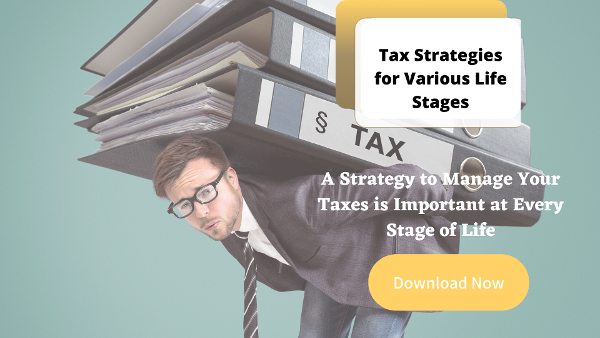
Tax Strategies for Retirees
Many if not most retirees will likely need to access money from savings to supplement Social Security and other sources of income in retirement. Be sure to schedule time with your adviser, retirement specialist or tax professional to help you identify a tax-efficient approach to accessing your savings. You may have heard that it is best to access your taxable account balances first to supplement your retirement income. However, if you are in a low tax-bracket at the start of retirement, an approach which accesses some funds from tax-deferred accounts may reduce your tax bill over time and extend the life of your retirement savings. At the same time, if you have a stock portfolio with a large portion of unrealized gains, you may decide to take advantage of realizing some of those gains if your taxable income is low enough where long-term capital gains and qualified dividends aren’t taxed.
Each situation is different and evolves over time. Taking the time to establish and continuously monitor a plan should serve you well in the long run. As a result of your careful planning prior to retirement, a substantial part of your retirement income may be derived through your IRA or qualified retirement plan Required Minimum Distributions (RMDs). Considerations around your RMDs will likely be a large part of your tax strategy.
Required Minimum Distributions (RMDs)
As documented on the IRS website, the Setting Every Community Up for Retirement Enhancement Act of 2019 (SECURE Act) became law on December 20, 2019. The Secure Act made major changes to the RMD rules. If you reached the age of 70½ in 2019 the prior rule applies, you must take your first RMD by April 1, 2020. If you reach age 70 ½ in 2020 or later, you must take your first RMD by April 1 of the year after you reach 72. Subsequent RMDs must be taken by December 31 of each year after the year you turned 72. Roth IRAs do not require withdrawals until after the death of the owner.
As you develop your tax strategy in retirement, here are some things to consider in planning your RMDs.
Multiple RMDs
If you have multiple IRAs (SEP and SIMPLE IRAs) you must calculate your RMD from each IRA, but you don’t have to distribute your RMD from each IRA. You can aggregate your RMDs and distribute all from one IRA, or you can proportionally distribute the RMD from multiple IRAs, or you can take the calculated RMD from each IRA. This decision is an opportunity for you to plan for the impact of the RMDs on your investments. Through this process you have an opportunity to rebalance your investments or consolidate the number of your IRAs by taking the full RMD from the smallest IRA so you may deplete its assets more quickly.
When consolidating your RMDs, remember to exclude the RMDs from inherited IRAs or employer plans such as 401(k)s which should be computed and taken separately.
Timing
You have options on when to take your RMD as long as you take it prior to the IRS deadline (April 1 of the year following the year when you turn 72 and December 31 for each year after the year you turn 72). You might decide to take monthly distributions which add up to the RMD to assist with your cash flow. Or you might time the distribution around a specific need for cash to cover a particular expense. Some people decide to take the full RMD at the beginning of the year so they know they have met the requirement, and other people opt to take the full RMD at the end of the year in order to try to maximize tax-deferred gains and income. Waiting until later in the year also allows you to delay paying estimated taxes on distributions.
There are no right or wrong answers when it comes to the timing, but you should definitely take this into consideration as you formulate your tax strategy.
Distribution Options
Did you know that you don’t have to distribute cash for your RMD? You can make an in-kind distribution which transfers assets from your IRA to a taxable account. An in-kind distribution allows you to remain invested and maintain your current overall asset allocation. The value of the shares on the day of the distribution must at least equal your RMD and will serve as the tax basis in the asset moving forward.
You can also use your RMD to make a Qualified Charitable Distribution (QCD). The charitable contribution is excluded from your gross income and counts toward the RMD for the year; however, you won’t receive a charitable contribution deduction. The contribution must be made directly from the traditional IRA to a charity by the IRA custodian or through a check payable directly to the charity. The limit on the exclusion is $100,000 per taxpayer, per year.
How to Get Started
These are just some things to consider as you formulate your tax strategy in retirement. If you’re looking for assistance with tax planning, contact your trusted financial adviser, and they should be able to give you advice and guide you through the process.
About Chase Investment Counsel
Chase Investment Counsel is a family and employee-owned boutique wealth management firm that offers personalized investment services. Our clients include career professionals, those nearing or in retirement, and families experiencing financial transitions such as generational wealth transfer, widowhood, divorce, or sale of a business. Chase’s active, disciplined investment management team is focused on selecting individual stocks and bonds targeted to each investor’s specific financial goals and risk tolerance. Established in 1957 in Charlottesville, VA, Chase Investment Counsel manages more than $300 million in assets.
